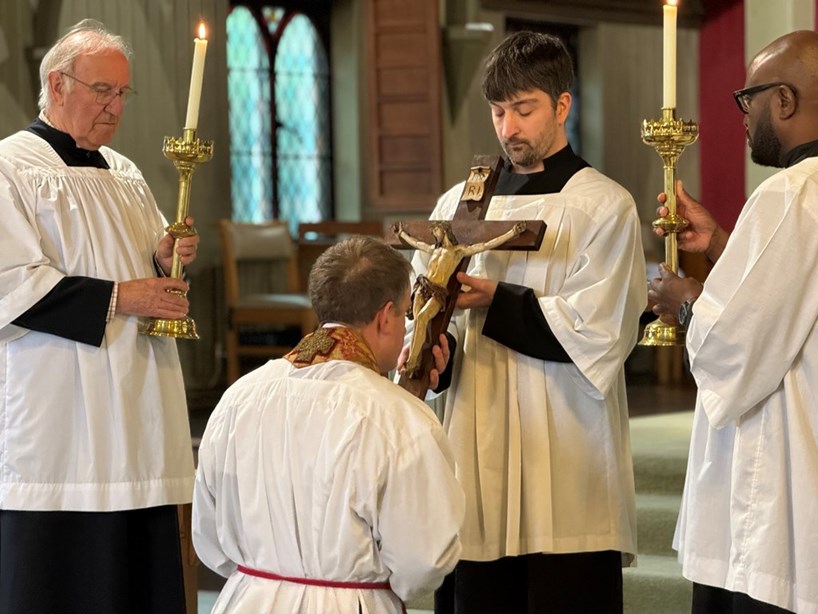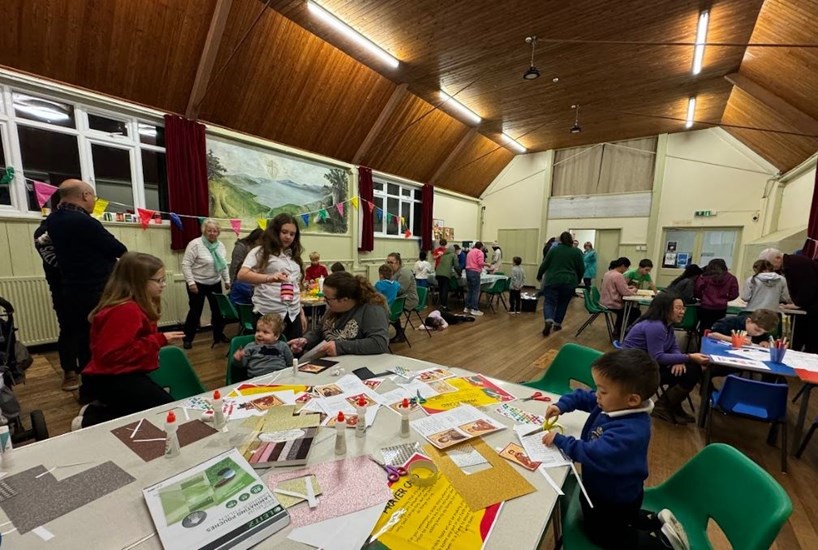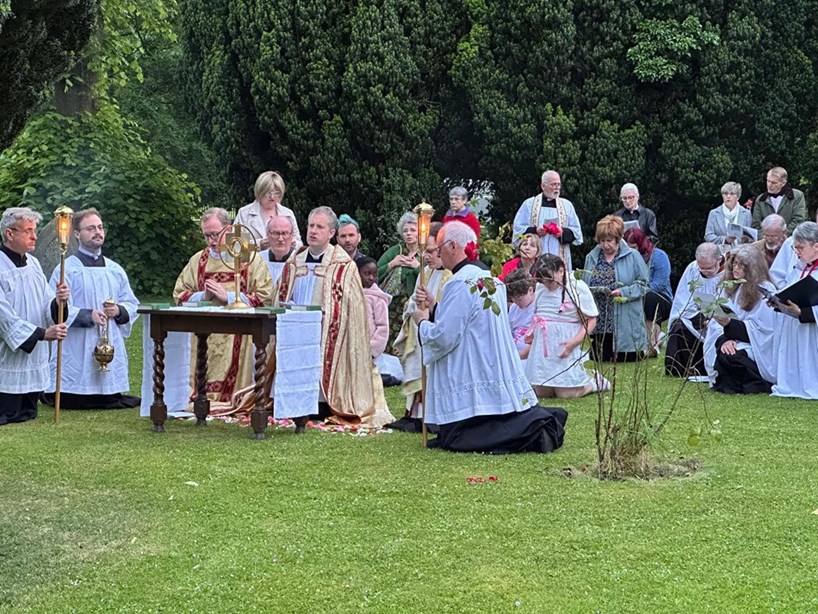SIR John Betjeman once remarked of St Mark’s, Swindon, that “its achievement lay in catholicising a parish, not merely a congregation”. Eighty years after Benjamin Britten’s Festival Te Deum was performed in the church, marking its centenary, the late Poet Laureate’s accolade has fresh impetus with the help of a £250,000 innovation grant from the Church Commissioners.
A summary of the project published in the latest report from the Strategic Investment Board (News,16 May) records that the church’s congregation, which, five years ago, stood at 15, has grown to more than 70, with children — once absent entirely — in double figures. A weekly vigil mass at St Luke’s, another church in the parish, with prayers and readings in Konkani (a Goan language), is attended by more than 60, of which children form a large proportion.
But growth locally is measured not only in numbers, but in lay confidence, and “active love for neighbour”, the Rector of Swindon New Town, the Revd Toby Boutle, says. “It’s about growth which is organic and properly rooted in the community — our sense of being a parish church which is there to serve a particular parish, which is close to the people within the community, there actively, visibly, loving and welcoming.”
He observes in an article for the see of Oswestry website that Betjeman’s tribute meant “not that everyone in the parish was sympathetic towards the externals of Catholic Christianity”, but that “the people of the parish as a whole have a more real conception of what the Church is, what she is intended to do, than is often found elsewhere”.
Fr Boutle, a former barrister and one-time speechwriter to William Hague, was appointed as the incumbent of Swindon New Town in 2020, after an interregnum of more than two years. At the time, the main act of worship at St Mark’s was a Saturday evening vigil mass attended by about 15 to 20 people. The parish had been asking “How do we keep going with the limited resources that we’ve got?” he recalls. “There was, perhaps, a bit of a siege mentality feeling”.
St Luke’s and St Saviour’s, the other two churches in the parish, were both plants from St Mark’s. In a review of a book marking the 1945 centenary, the Church Times noted that the church had “inspired a singular degree of affection and self-sacrificing service in the industrial population of Swindon”, where the Great Western Railway had “transformed a sleepy village into a great industrial town” (Books, 4 May 1945). The company had paid part of the incumbent’s stipend, and allowed one of its factory rooms to be used for church services.
St Saviour’s is one of the few remaining C of E churches built entirely by voluntary labour, constructed from wood in 1880 by railway workers on their day off: “A little army of carpenters, masons, gas-fitters, and labourers of all kinds constructed a church to hold one hundred and eighty in just over six months.” The Bishop of Bristol, Dr Forrest Browne, wielded a spade and signed himself on the list of volunteers as “bishop and excavator”.
 SWINDON NEW TOWN PARISHGood Friday at St Saviour’s
SWINDON NEW TOWN PARISHGood Friday at St Saviour’s
The parish became a celebrated source of priestly vocations — estimated to number 100 in the century to 1975 — partly due to the work of the Revd the Hon. Maurice Ponsonby (fourth Baron de Mauley) who served for 24 years after his arrival in 1879.
It is a proud history recalled by Fr Boutle, who says that, even in the 1960s and 1970s, there were “huge staff teams” and active service from Wantage Sisters. Since then, “the experience of most parishioners had been of clerical resources reducing year on year, but there being no corresponding increase in lay ministry,” he says. The congregations were “ready for change”.
The £4.8-million Innovation Fund was announced by the Archbishops’ Council in 2021: dioceses were invited to bid for projects that could “test the assumptions we make about how or why growth may or may not occur” (News, 12 October 2021). Grants of up to £250,000 were made available for projects lasting up to three years, which had to support the national Vision and Strategy. It ended up 2022, when 18 grants were agreed.
Among the recommendations of the Chote review of the Council’s grants programmes was the need for “greater intentionality in ensuring that support is deployed across the full range of traditions” (News, 10 March 2022). Swindon is also home to Pattern Church, a Holy Trinity, Brompton, plant opened in 2018 at a cost of £6.45 million, including a £1.69-million strategic development grant (News, 21 December 2018).
Fr Boutle, who drafted the bid in 2022 with the support of the diocese of Bristol, recalls close working with the PCC. The idea had been to ask “If we had the resources, what might we be able to try?” rather than to think “We don’t have enough resources, we better do a bit less.” The application was a “quite rigorous and difficult” process, he says, requiring “a lot of quite specialist work, that I think as a parish priest one might just feel really not ready to do. I think a lot of it is about confidence and capacity.”
The innovation bid project was launched in February 2023. In addition to the grant of £250,000, the parish secured support from charities, including the Confraternity of the Blessed Sacrament and the Additional Curates Society. The total is close to £400,000 for a five-year period, enabling the funding of a full-time Mission Priest, Fr Adam Burnham; a lay worker, Tom Dumbell; and project management support. Fr Tim Davies is serving his curacy in the parish.
The Strategic Investment Board summary says that the parish — the only Traditional Catholic parish in the archdeaconry — has been “exploring what good church growth looks like in a traditional Catholic context”, including “the centrality of mass in church growth”.
 SWINDON NEW TOWN PARISHMessy Church activities
SWINDON NEW TOWN PARISHMessy Church activities
“The eucharist is at the heart of evangelisation, because evangelisation means incorporation into the active body of Christ, which we see at its fullness in the mass” observes Fr Boutle. “But also, the idea of us being actively sent out having been fed by the eucharist, and the idea of people being drawn into genuine community and genuine neighbourliness.”
The parish’s monthly Messy Church is eucharistic — a response to the Messy Church “mantra” that “This is church, this isn’t just preparation for church,” Fr Boutle says. “If it is to be the fullness of what the church is, that means it has to have some relationship with the eucharistic community.” In addition to activities including crafts, there is a 30-minute mass in the church with a children’s choir and young people serving and reading.
There is now a Sunday school at all three of the parish churches. “Messy Church has increased young people’s confidence and active participation in the liturgy,” Fr Boutle says. Asked about growing a children’s ministry from a standing start, he suggests that “consistency really matters. On the occasion when a family turns up, is there going to be something there for them? Those running our Sunday school were really ready for the fact that no one might turn up.” Within the parish, resources and expertise are shared.
Growth has also come from increasing the Konkani mass from monthly to weekly (Goan children tend to stay throughout the service, Fr Boutle says), and from welcoming refugees and asylum-seekers. Once home to a white working-class population, many of the younger congregation are from ethnic minority backgrounds, reflecting changing demographics in Swindon. Activities include a toddler group, youth group, and “welcome space”.
One of the hypotheses tested by the project is “whether by deliberately increasing clerical capacity that was a way of increasing lay capacity,” Fr Boutle says. “I think this has worked in practice.” It is important not to see lay ministry as “a panic measure response to a reduction in clergy numbers”, he says. Lay people are currently giving a series of talks — “Grace at the ground level” — on how their faith affects their daily life, including Gavin — a tattoo artist who started attending church after reading the Bible twice — who will be talking on “Ink and icon: Tattoos as testimony”.
 SWINDON NEW TOWN PARISHCorpus Christi at St Mark’s, Swindon
SWINDON NEW TOWN PARISHCorpus Christi at St Mark’s, Swindon
“Sometimes, we’ve had loads of new people at St Mark’s, and it hasn’t really been clear to me where they have come from,” Fr Boutle reflects. “I think there is this sense of a new generation of people being interested in faith and wanting to come along and turn up, and wanting church which doesn’t look like the world, that looks like they might imagine church to look.”
He senses “renewed confidence” in the Traditionalist wing of the Church. “A confidence based on a willingness to share our gifts — in saying not that we are there to put to form some pure sect within the Church of England, but to share those charisms we have more widely . . . which means having good and warm relations with our brothers and sisters.” The Bishop of Bristol’s support was crucial in securing the innovation funding, he says.
The Church Times obituary for his 19th-century predecessor opined that, “wholeheartedly Catholic in his teaching, Lord de Mauley was content to work slowly and patiently in order that he might build on a firm foundation” (Gazette, 23 March 1945). Eighty years later, the work continues.















